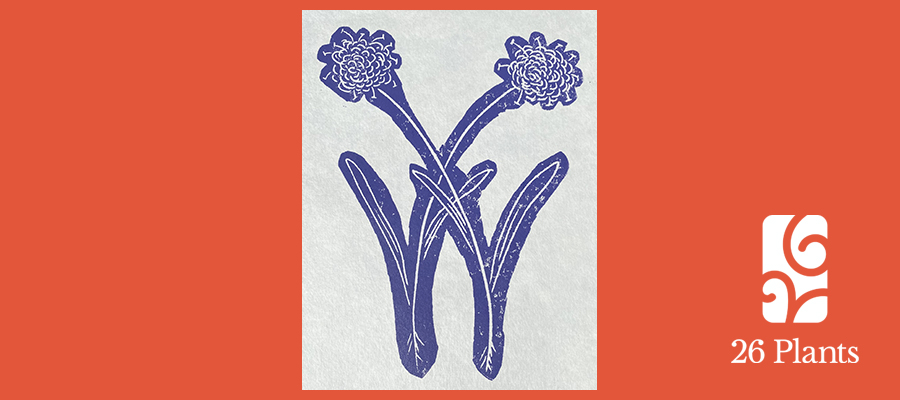Devil’s-bit Scabious
Succisa pratensis
Lisa Andrews

the devil’s work
lurks in these black-bitten roots
and there’s witchery
carved in the capillaries
so that lilac-puffed pincushions
may scratch
a Culpepper prayer
answered in meadow and hedgerow.
summer’s end brews late nectar
nourishing wing and skin
blinding evil eye
as stubby roots distil a goblet charm
with the power to purify.
but Lucifer has long disowned his work,
this nodding herb that heals
a little too well.
so with envy-tipped teeth
he rips at the root
that feeds the herb that nurtures life,
weaving his own pestilent spell
until it’s clear for all to see
the devil’s work.
Anything with the word devil in its title is bound to have a good back story. And Devil’s-bit scabious (Succisa pratensis) does not disappoint.
This lovely perennial, with its nodding blue-violet pompom heads and long oval leaves, is a member of the honeysuckle family, flowering between July and October in damp meadows and marshes, along riverbanks and woodland rises.
But it is the roots that most interested Lucifer. Legend has it he bit them off in rage because of their ability to treat skin conditions, including scabies and the sores caused by bubonic plague, leaving short, black stumps.
Indeed, Nicholas Culpeper wrote in his Complete Herbal that – when boiled in wine and drunk – the roots are “very powerful against the plague, and all pestilential diseases or fevers, poisons also, and the bitings of venomous beasts…”
Culpeper went on to extol the plant’s virtues in helping to heal bruises, swelling of the ‘almonds’ (lymph nodes) and throat, menstruation and bowel pain. He even suggested it could help rid the skin of freckles.
While Devil’s-bit scabious is rarely used in modern herbal medicine today, it remains an essential lifeline for a host of butterflies and bees, including the wonderfully named narrow-bordered bee hawk-moth.
Most crucially, it is the foodplant for the endangered marsh fritillary butterfly. This beautiful chequerboard butterfly was once found right across Britain and Ireland. However, numbers have declined drastically over the last century with populations now largely confined to western areas.
The connection between Devil’s-bit scabious and the marsh fritillary are particularly clear in Cumbria, where the butterfly has come back from the dead – two decades after it was declared extinct in the region.
It’s all thanks to changes in grazing at a site in the Swindale valley (now managed by the RSPB), which means that the coarse grasses once covering the ground – that grazing ewes refused to eat – is now a haven for wildflowers, including Devil’s-bit scabious.
As well as radically lowering the number of ewes and implementing rotational grazing on lowland farmland, every late autumn the charity introduces native fell ponies to the site. Their willingness to chomp through the grasses opens up space for flowers to emerge the following spring and summer.
As senior site manager Lee Schofield told The Guardian in June 2023: “These flowers have spread and spread over the last few years. The fell ponies are the key to this success – if we hadn’t changed the grazing and used these big native herbivores we wouldn’t have the scabious and we wouldn’t have the butterfly.”
It is a powerful reminder of how the choices we make affect the landscape. And, perhaps we should also be grateful that the Devil was a little slapdash in his work. After all, if he’d eaten the whole plant we’d have no marsh fritillary at all.
Image by Lisa Andrews
